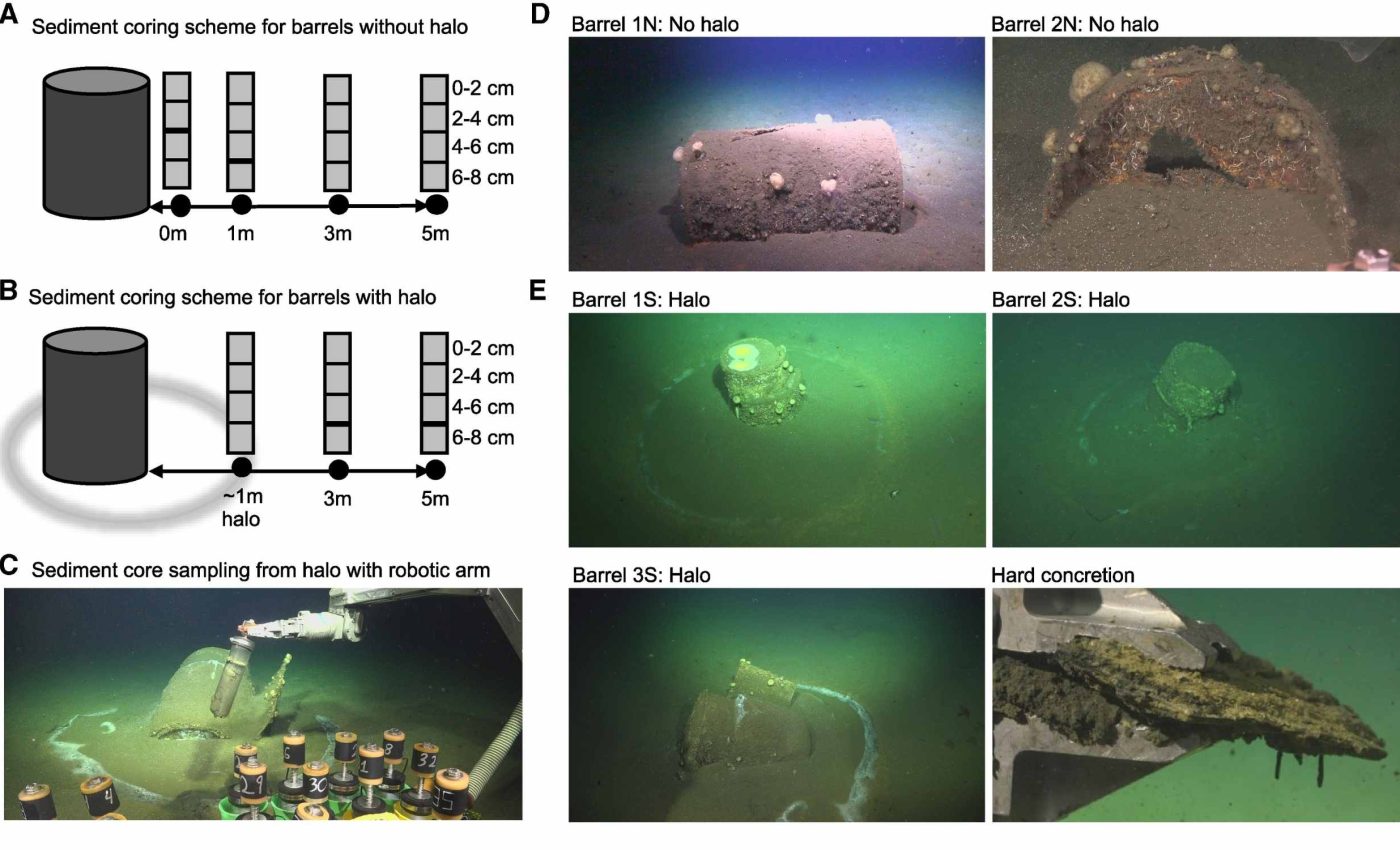
Barrels dumped off the coast of Los Angeles are so toxic that not even bacteria can survive
Far off the coast of Los Angeles, rusting barrels leak a caustic chemical DDT soup that kills most microbes around them. These barrels rest on the seafloor about 3,200 feet down, forming pale rings in the sediment that look sterile.
An analysis of seafloor mud shows that some barrels are not filled with the pesticide DDT, but with caustic waste. In this case, alkaline, strongly basic on the scale chemists use for acidity, describes the waste.
DDT barrel junkyard
From the 1930s into the early 1970s, regulators signed off on ocean dumping of industrial waste off Southern California.
Federal records describe 14 deep water disposal sites that received refinery sludge, chemical waste, garbage, explosives, and radioactive material.
The new work on the halo barrels was led by Johanna Gutleben, a postdoctoral scholar at Scripps Institution of Oceanography at UC San Diego. Her research focuses on deep sea microbial communities and how human pollution shapes them.
Decades later, camera surveys and sonar revealed corroded steel barrels scattered across the seafloor between the Palos Verdes Peninsula and Santa Catalina Island.
One recent mapping effort flagged about 25,000 barrel shaped objects on the bottom, hinting at an underwater junkyard.
In many of the survey photos, a chalky white ring circles each suspect barrel, standing out sharply against the darker seafloor mud.
Scientists nicknamed the features halos, but until recently no one could agree on what was causing them or what sat inside the barrels.
From DDT fears to a different threat
The pesticide DDT was banned in the United States in 1972 after evidence showed it was damaging wildlife and raising cancer risk in people. It lingers in soil and water and builds up in animal fat, making it a long-lasting pollutant.
In Southern California, a chemical plant’s waste left DDT packed into seafloor mud along the Palos Verdes Shelf and nearby waters.
Scientists later found that many marine mammals and seabirds in the region still carry DDT and related compounds in their bodies.
When the halo barrels first showed up on sonar and video, many people suspected they were the main source of offshore DDT pollution. Sediment cores in the new research showed high DDT, yet values stayed similar whether samples were taken near a barrel or several feet away.
“We only find what we are looking for and up to this point we have mostly been looking for DDT.” Gutleben is a microbiologist at Scripps and lead author of the study.
Alkaline waste and DDT barrels
When Gutleben’s team sampled mud inside the halos, they found the surrounding water had a pH near 12, close to household bleach. In this context, pH stayed so high that almost nothing could grow.
Leaking alkaline waste reacts with magnesium in seawater and forms brucite, a magnesium hydroxide mineral that hardens mud into a concrete like crust.
In some cores, this brucite rich layer formed a solid ring around the barrel that even a coring tube could not push through.
As the brucite slowly dissolves, high pH fluid seeps upward and triggers precipitation of calcium carbonate, a white mineral found in chalk and shells.
Those particles settle as pale dust in a ring around the crust, creating the visible halos that make the barrel sites easy to spot.
From the pattern of halos and crusts seen so far, the team estimates that one third of the surveyed barrels once held alkaline waste.
Because each halo stands out clearly on camera, this chemistry leaves a visual label that helps agencies decide which sites need closer attention.
Extremophile life at the edge
Inside the halos, the researchers struggled to pull enough DNA out of the mud to even analyze the microbes living there.
Where they did succeed, they found a microbial community, a small set of microscopic species, with fewer kinds of bacteria than in nearby sediments.
Genetic sequencing showed that the dominant bacteria in the halos are close relatives of species that thrive in hyperalkaline hydrothermal vents and hot springs.
Similar microbes inhabit the Lost City hydrothermal field, where communities live in fluids at pH 9 to 11.
Because of the high pH around the halos, this site has become a hotspot where only a few tough microbes can survive. Scientists call such organisms extremophiles, organisms adapted to extreme conditions.
Just a short distance away from the halos, the seafloor mud still supports dense, diverse microbial life more typical of deep ocean sediments.
That sharp contrast shows how a single leaking barrel can carve out a tiny chemical island that feels almost separate from the surrounding ecosystem.
Lessons from the DDT barrels
The barrels went into the water decades ago, yet the caustic waste they carried still alters chemistry in the deep San Pedro Basin.
Laboratory estimates of how fast brucite dissolves suggest that, once created, concrete like crusts and halos could persist for thousands of years.
Because the waste has not quickly diluted in seawater, the authors argue that it should be treated as a persistent pollutant. In this context, persistent pollutants put alkaline waste in a league with other stubborn chemicals.
“It’s shocking that 50-plus years later you’re still seeing these effects.” Paul Jensen is an emeritus marine microbiologist at Scripps and senior author of the study.
The deep location and remote setting make it hard to monitor these dumps. Even so, agencies model ways that contaminants might move from the seafloor into fish, marine mammals, and ultimately human diets.
The study is published in PNAS Nexus.
—–
Like what you read? Subscribe to our newsletter for engaging articles, exclusive content, and the latest updates.
Check us out on EarthSnap, a free app brought to you by Eric Ralls and Earth.com.
—–













